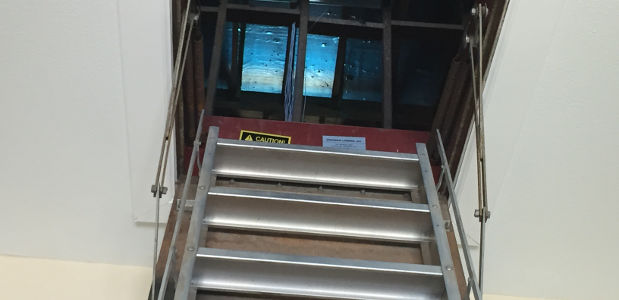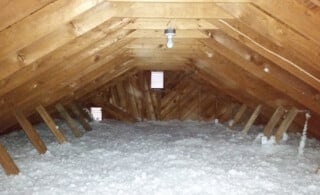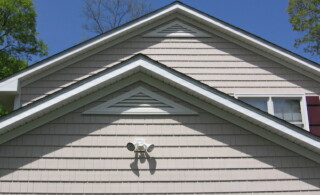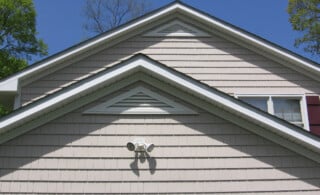
If you think attic ladders are only good for climbing, you haven’t even scratched the surface of what they have to offer. Of course they are primarily functional (How else are you supposed to get into your roof-level storage areas?), but they also come with a wide variety of options that have improved the product’s design, safety, and convenience.
Design
Most models are made out of wood or metal, both of which have their own pros and cons. Wood ladders are made out of dowels and are usually less expensive that metal units. Plus, they have a nice finish for easy painting or staining. Aluminum and fiberglass ladders are typically more expensive, but they are also sturdier and longer-lasting than wooden units. Plus, they can hold a significant amount of weight (up to 300 pounds) for assured protection when carrying heavy objects into your attic.
Besides their basic material, each ladder has its own unique design. Most are hinged into two or three unfolding sections (depending on the ceiling height) so that they take up less space in the actual attic when they lay flat against the floor. Most attic trapdoors come with a pull string that when gently tugged allows the hinged ladder to smoothly unfold on its own due to an easy-gliding spring system. However, there are a few versions out on the market right now which offer a more unique design:
- Stairsteps: These ladders actually unfold into a temporary staircase, allowing for easy ascension into the attic; however they may cost a bit more and they also take up additional overhead clearance when they fold up into the storage space due to their more bulky and complicated construction.
- Telescoping ladders: These aluminum ladders descend straight down from the ceiling and are adjustable in their length. Through a changeable lock-and-release system, these particular ladders can fit into any space and are especially useful in smaller areas, such as crawlspaces. Plus, since they can be compressed, they don’t take up any storage space in the attic itself.
Safety
Transporting personal items into an overhead storage space can be particularly dangerous since you since you have to lug heavy objects in your arms while still using your hands for climbing. Therefore, attic ladders have come with an assortment of safety features to make this chore more manageable. Although you should always make sure you get extra help when lifting bulkier items into an attic, some accessories may help the challenge become easier.
- Handrails: Most ladders now come with built-on handrails, so you no longer have to depend solely on the rungs.
- Lights: When opened, some ladders will come with attached lights that will automatically turn on so that you can see where you’re going.
- No-slip Treads: Ladders now come with rubber stripping or other no-slip materials attached to each rung to reduce the chance of accident.
- No-slip Feet: On the feet of the ladder, there are now rubber tips available in order to secure balance and to ensure its hold to the floor while you climb.
- Locks: Trapdoors also come with locking systems to protect against break-ins.
- Fireproofing: Ladders are usually proofed against fire to resist against further damage.
Convenience
Since most homes do not have walk-in attics, many homeowners depend on the trapdoor and attic door combination. Of course these come with pull cords, but what if you have a high ceiling? Don’t worry: taller trapdoors come with a rod that can slip through the ring at the end of the pull string for easy leverage. Since ladders come with a spring system, not much strength is needed to pull it down, and often these systems shut slowly so there is no creaking or slamming upon closure. These folding ladders can also come with covers to protect the unit and to properly seal the trapdoor for energy efficient savings.
Though most units are pre-assembled for easy installation, if might be best to hire a professional for quality assurance. These tasks can probably be accomplished by the manufacturer, but any handyman should be able to complete the job. If you do decide to put the ladder in yourself, make sure you properly measure the opening of your attic before making the purchase so that you buy the appropriate-sized unit, and make sure you consult your manufacturer for advice beforehand because as with any home improvement: a product is only as good as its installation.
 Attic Ventilation Myths That are Off the Charts
Attic Ventilation Myths That are Off the Charts  Roof Insulation Captures Escaping Energy
Roof Insulation Captures Escaping Energy  Ridge Vents Can Help Let Off Some Steam
Ridge Vents Can Help Let Off Some Steam  Gable Vents: Let Your Attic Breathe
Gable Vents: Let Your Attic Breathe  Are Dormers Right for Your Home? A Look at the Pros and Cons
Are Dormers Right for Your Home? A Look at the Pros and Cons 

Are You Familiar With This Topic? Share Your Experience.